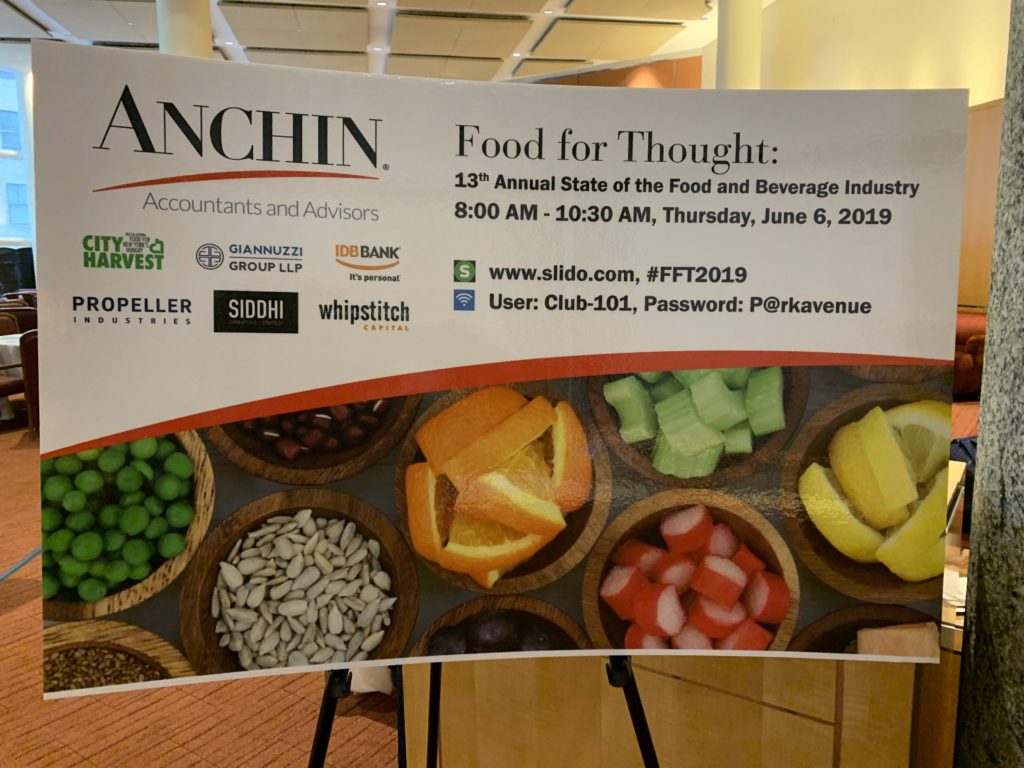Amy Stern - 06/13/2019
The 13th Annual State of the Food and Beverage Industry event provided valuable insights on CPG, retail/supermarket, and manufacturing/distributing trends. 3E PR uses this knowledge to develop highly effective media relations, content development and social media campaigns for food brands.
As a public relations agency with a strong background in food PR, 3E PR recently had the exciting opportunity to attend the 13th Annual State of the Food and Beverage Industry event sponsored by Anchin, accountants and advisors supporting entrepreneurial businesses. In addition to learnings from Anchin’s annual industry survey on CPG, retail/supermarket, and manufacturing/distributing, we enjoyed a dynamic conversation about food industry trends featuring insights from movers and shakers in the category. All this market knowledge helps us more effectively develop media relations, content development and social media campaigns for food brands. Here’s a review of what we learned.
What the data shows – Food & Beverage Trends 2019
 Anchin targets early stage companies, including food start-ups, with potential for high growth, creating expert solutions to assist privately held businesses. Insights on food and beverage trends were gathered, examined, and categorized by three key industry sectors:
Anchin targets early stage companies, including food start-ups, with potential for high growth, creating expert solutions to assist privately held businesses. Insights on food and beverage trends were gathered, examined, and categorized by three key industry sectors:
- Branded Companies (CPG)
- Retail/Supermarkets
- Manufacturers and Distributors
Let’s take a bit of a deeper dive into each.
Trends in CPG
When asked what the greatest driving force for new sales was in 2018, branded companies responded as follows with answers in descending order:
- New Customers
- New Product Offerings
- Developing New Brands
- Marketing & Promotions
- Competitive Pricing
- Private Label
Growth drivers for this group continue to be organic and plant-based products, something that has spawned a flurry of investor activity of late.
Regarding 2018 expenditures, branded companies and CPGs said they were most surprised as to how much they invested in trade and promotions, with actual spending exceeding budget projections. The anticipation is that this trend will likely continue.
Brands were also asked in what areas they expected to make a significant investment. By far, advertising and marketing surpassed labor costs and R&D, with facility expansion and business acquisition lagging far behind. When asked about their greatest challenge overall, most respondents said financing/cash flow topped the list, followed closely by concerns about where and how to find new distribution channels.
Trends in the Retail/Supermarket Sector
Retailers and supermarket respondents cited labor costs as their greatest expense in 2018. The response makes sense given that retailers also reflected the workface as the single category in which they anticipated making the most significant investment this year.
The theme also resonated as the greatest challenge they faced last year overall. Most expect to continue feeling the pinch and pain, as advocacy regarding increasing the minimum wage continues to impact employers, positively impacting the labor force, but significantly affecting retailer’s profit margins.
The impact of labor costs has led to innovation for savvy retailers, especially those willing to change the status quo.
What are Manufacturers /Distributors Seeing?
Fresh customers made up 59% of new sales for manufacturers and distributors in the food and beverage industry, with new product offerings a distant second at 20%. The biggest expenses for this group were freight and labor, both exceeding budgetary targets. Regarding investments, most said they plan to heavily invest in technology in the coming year. Their greatest challenge? Labor costs.
Another key benefit of the Anchin event was exposure to a team of industry leaders that not only presented their feedback on the survey findings, but discussed additional industry insights, as well.
Future of CPG
Panelists seemed to have conflicting views regarding the future of CPG. One perspective shared by several speakers was that the model on which CPG companies were built no longer works.
“They were industrial business models that don’t have innovation as part of their model,” said Hans Taparia, entrepreneur and co-founder of Tasty Bite. “Their infrastructure isn’t malleable for the foods of tomorrow. The reason that their goods are cheap is because versatility doesn’t exist.”
Mike Messersmith, U.S. General Manager of Oatly, makers of uber-popular high-fiber oat milk, spoke in defense of multi-national CPGs. Having previously worked at Frito-Lay, he concurred that the operational supply chain at most big brands is not versatile but admitted he had seen some solid examples of innovation in new products while at Frito-Lay. Unlike another panelist who felt CPGs just couldn’t see certain things, Mike said he believed that big CPGs recognize these aspects, but that the diversity of their portfolio holds them back. His advice to the audience, “Do one thing incredibly well! At Oatly, we are manically focused on just one thing.”
Taparia’s perspective, “Most CPG companies won’t be able to buy their way out of the current state of affairs,” he says. For additional background on the state of CPGs, see our blog post about what’s shaking up the CPG industry.
How Do We Achieve Innovation?
According to Danielle Gould, Founder of Food & Tech Connect, “It’s the impatient investor that is driving innovation. When companies have to answer to a board of directors, it’s often the board that shuts things down.”
She later suggested the possibility of eliminating quarterly reporting to free up the potential for innovation. Many on the panel felt that being so closely tied to standard financial reporting structures and the classic board of directors/shareholder model was indeed paralyzing for branded companies.
Gould said she felt strongly that “private equity has changed the face of food and beverage.” These “activist investors” are impatient and that’s what’s driving action, change and ultimately the evolution of the industry.
When asked if the future was more branded companies buying smaller innovative brands or doing the innovating from within, panelists said some companies were doing both, but that the reality was the old model isn’t adaptable.
Zoe Feldman, Director of the Chobani Incubator, said their focus is on diversity and inclusion, “giving those under-represented voices a seat at the table.” As a result, the incubator has churned out several winning new products. Feldman admitted that Chobani’s model is altruistic, but they can afford to be and that’s largely due to their nimbleness and elimination of bureaucracy. The results: a diverse portfolio of innovative products with an increased ability to enter the supply chain faster and easier than ever before.
 If you’re an entrepreneur with an innovative new product launching at market or a CPG that needs support, learn how 3E PR can amplify your brand awareness and bring recognition at retail, even in the most competitive of categories. Email me at Astern@3epr.com and let’s discuss how we can grow your business.
If you’re an entrepreneur with an innovative new product launching at market or a CPG that needs support, learn how 3E PR can amplify your brand awareness and bring recognition at retail, even in the most competitive of categories. Email me at Astern@3epr.com and let’s discuss how we can grow your business.
